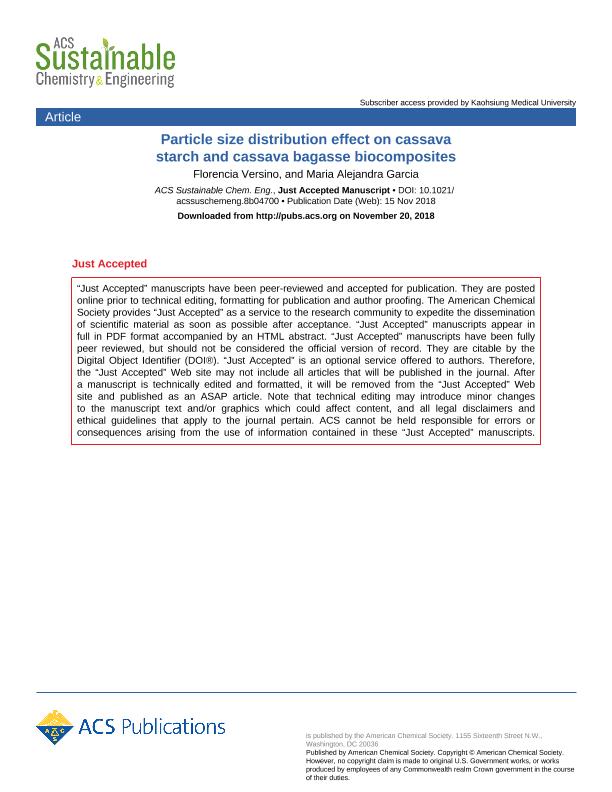Artículo
Particle Size Distribution Effect on Cassava Starch and Cassava Bagasse Biocomposites
Fecha de publicación:
01/2019
Editorial:
American Chemical Society
Revista:
ACS Sustainable Chemistry and Engineering
e-ISSN:
2168-0485
Idioma:
Inglés
Tipo de recurso:
Artículo publicado
Clasificación temática:
Resumen
Regarding the growing interest in the development of biodegradable films from renewable sources, this work is focused on the utilization of cassava roots bagasse as a natural filler of cassava starch films. Homogenous films could be obtained by casting molding from gelatinized cassava starch suspensions, plasticized with glycerol and containing 1.5% w/w bagasse. In order to study the particle size effect on films properties, three different fibrous residue fractions (particles sized between 500-250, 250-53, and particles <53 μm) were used and compared to films reinforced with bagasse particles sized under 500 μm. Chemical composition and particle size distribution of cassava bagasse helped to explain the starch films morphology and mechanical and barrier properties modifications. SEM micrographs evidenced that the filler was structurally incorporated in the matrix, reinforcing cassava-starch matrices regardless of bagasse particle size. The filler increased the UV-barrier capacity and opacity of the materials, though water vapor permeability increased with solids content and filler particle size. Moreover, the developed biocomposite materials can be heat-sealed, indicating their suitability for flexible packaging manufacture. Even though starch-based materials are essentially biodegradable, the biodegradation kinetics of the reinforced biocomposites was studied showing the slowest degradation process for materials with larger filler particles.
Archivos asociados
Licencia
Identificadores
Colecciones
Articulos(CIDCA)
Articulos de CENTRO DE INV EN CRIOTECNOLOGIA DE ALIMENTOS (I)
Articulos de CENTRO DE INV EN CRIOTECNOLOGIA DE ALIMENTOS (I)
Citación
Versino, Florencia; Garcia, Maria Alejandra; Particle Size Distribution Effect on Cassava Starch and Cassava Bagasse Biocomposites; American Chemical Society; ACS Sustainable Chemistry and Engineering; 7; 1; 1-2019; 1052-1060
Compartir
Altmétricas




